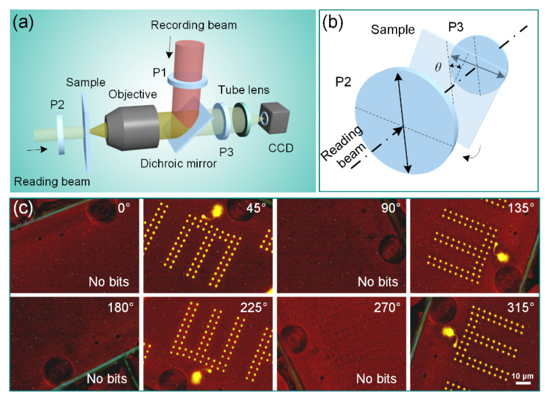R&D: Two-Stage Optical Recording
Photoinduced birefringence and surface-mediated bits storage in bisazo-containing copolymers towards ultra high data memory
This is a Press Release edited by StorageNewsletter.com on November 28, 2016 at 2:42 pmOptics Express has published an article written by Yanlei Hu, Dong Wu, Jiawen Li, Wenhao Huang, and Jiaru Chu, Department of Precision Machinery and Precision Instrumentation, University of Science and Technology of China, Hefei 230026, China.
Fig. 1. (a) Illustration of the optical setup for polarization recording and readout.
(b) Schematic diagram of the readout configuration.
(c) Bits readout results when rotating the sample at
different angles to the polarization of P1.
Here a laser power of 20mW and an exposure time of 50ms
are used for bits recording. The interval between neighboring bits is 4μm.
Abstract: “Ultrahigh density data storage is in high demand in the current age of big data and thus motivates many innovative storage technologies. Femtosecond laser induced multi-dimensional optical data storage is an appealing method to fulfill the demand of ultrahigh storage capacity. Here we report a femtosecond laser induced two-stage optical storage in bisazobenzene copolymer films by manipulating the recording energies. Different mechanisms can be selected for specified memory use: two-photon isomerization (TPI) and laser induced surface deformation. Giant birefringence can be generated by TPI and brings about high signal-to-noise ratio (>20 dB) multi-dimensional reversible storage. Polarization-dependent surface deformation arises when increasing the recording energy, which not only facilitates the multi-level storage by black bits (dots), but also enhances the bits’ readout signal and storing stability. This facile bits recording method, which enables completely different recording mechanisms in an identical storage medium, paves the way for sustainable big data storage.”
© 2016 Optical Society of America













 Subscribe to our free daily newsletter
Subscribe to our free daily newsletter
